Elsie Janis has long been known by many as the Sweetheart of the A.E.F., a title which is perpetuated on her headstone. But it was a long climb to the attainment of that title. The story of Elsie is also deeply intertwined with her start in the ragtime era and the continuing presence of her doting mother. In spite of how well known both of them became, finding some information on their origins which is not present in most biographies of Janis, or at least accurate information were such origins are suggested, was a challenge at the very least because both were rather "forgetful" about many details of their life, including their names and their age, the latter being highly variable over time. Some deep searches by the author uncovered much of this information, and some will be presented here for perhaps the first time, or at least the first time in one place.
Elsie's mother was born Jennie Cockrell on August 13, 1861 (she regularly claimed anywhere from 1867 to 1875 later on) to Hiram Cockrell and his bride Nancy Oldham in Delaware, Ohio. The Cockrells traced their lineage back to an arrival in the United States in 1757. Jennie's name may have been Jane at birth, but consistently shows up as Jennie in public records. One of her father's close cousins was Senator Francis Marion Cockrell of Missouri, of which there is a traceable connection, and which she did mention in an interview at some point. The 1870 census showed her to be eight years old.
The family moved to Centervillage, Ohio in the early 1870s where Hiram remained for most of his life. In 1880 Jennie appeared as a boarder in nearby Mansfield, Ohio, working as a trimmer in a large millinery (hat makers). On May 1, 1881 Jennie was married to John Eleazar Bierbower, who was born in Marion, Ohio, in a ceremony in Bucyrus, Ohio. They spent some time around Indianapolis, Indiana, where Percy John Bierbower was born on January 8, 1885. By the late 1880s the family had moved to the area around Ohio's capitol city, Columbus. Elsie Jane Bierbower, was born there on March 16, 1889. In later years she would have birth years listed in census records and on passports that varied from 1892 to 1895, the latter year most consistently, but there is no question of the actual year of birth, admitted later in a Time magazine article.
It was apparent before Elsie was even two that she was a natural entertainer. As "Baby Elsie" she started singing for activities held at the First Congregational Church in Columbus at the age of two and a half. Jennie was delighted with the reception and quickly caught the management bug that many proud stage mothers were likely to get. She started getting appearances for "Little Elsie" as a singer, and finally secured her a stage debut as a singer/actress at age six in the Great Southern Theater production of East Lynne in Columbus with the James Neil Stock Company. Elsie (or Jennie) also caught the attention of the wife of then-Governor William McKinley, and the child performed for the McKinleys at the official governor's residence, the Neil House. One of his favorite tunes that Elsie sang was reportedly Break the News to Mother. As much as Jennie, and reportedly Elsie, enjoyed their growing fame and occasional travel, Elsie's father John did not approve of the theatrical life for his children.
Rather than deny her daughter, much less herself, the opportunities afforded by Elsie's inherent talent, Jennie divorced John in the late 1890s. She then gave both herself and her daughter a new identity.
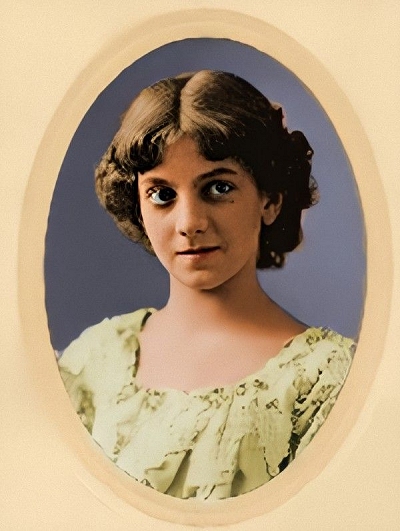 |
The last name of Janis, by some accounts, was derived from Jennie's alleged first name of Jane, or even Janis, which is hard to confirm since neither name appears in public records that were located. It was perhaps even more likely that it was derived from Elsie's middle name of Jane. In any case, Elsie Janis became the performer's permanent name (legal papers on this name change were evasive, so the legality is uncertain) and Jennie Cockrell Bierbower became Josephine Janis, professional stage manager with only one client throughout her career.
Now making theater appearances with a local stock company, Elsie herself had the stage bug. Josephine parlayed their previous acquaintance with the McKinleys to receive an invitation for Elsie to perform in the White House where the couple now lived as President and First Lady. Given how well that went, Josephine next set her sights on the vaudeville stage for Little Elsie, now around ten. She went to vaudeville manager Mike Shea proposing he try the girl for a week. After that time she would either hit the bricks or he would pay her $125 per week. Put right after the opening on her first day, a make or break position, she was moved to second from closing by the end of the day, a position afforded only to top performers.
So it was that Elsie, with Josephine in tow, spent the next few seasons performing in vaudeville stock companies. Yet they remained based in Columbus at this time, albeit in a nicer home. The mother/daughter team would call their High Street home across from Buckeye Field, part of the University of Ohio campus, ElJan, and Elsie would not part with it until after Josephine died. They were on the road at the time the 1900 census was taken, so concerted attempts to locate them in that year proved fruitless, but they do appear there in local Ohio records.
Percy was difficult to locate in the 1900 record, and may have been residing with his father at the time. However, after working in mercantile for a while he also got the same ailment his sister had, desiring to appear on the stage. His debut was reportedly around 1903 in Nixon and Zimmerman's production of The Strollers. Likely encouraged by his mother, Percy also adopted the last name of Janis. As Percy Janis he soon appeared with his younger sister in plays as well, and started working toward his own career in vaudeville.
Among the emerging talents that Elsie possessed was that of imitation. She was able to do quite passable imitations of many celebrities of the time, including President McKinley and eclectic singing star Sarah Bernhardt. With the variety of talents she developed, Elsie was able to form a viable act that could sustain the larger part of a vaudeville show. Yet in spite of her good press, the child actress was not allowed to work in New York City for some time due to local child labor laws strongly enforced by The Society for the Prevention of Cruelty to Children, who also set limitations on youngsters Eddie Cantor, Al Jolson and Buster Keaton. In the case of Keaton the abuse was very real. But as for Elsie, her mother was her mentor, guide and protector. Added to her act were more impersonations, including vaudeville star Eddie Foy, himself a caricature, George M. Cohan in his gung-ho all-American style, Harry Lauder and his Scottish antics, and the patriarch of the great acting family, John Barrymore.
In 1905, After several years of vaudeville touring and summer stock, Elsie, now nearing 16, replaced Anna Held for a tour of The Little Duchess, staged by Held's husband Florenz Ziegfeld. The tour was a success, and the following year Janis was offered a role in The Vanderbilt Cup on Broadway.
Two productions of this ran for 143 performances in 1906 and 48 performances in 1907. Among the highlights were racer Barney Oldfield simulating the titular car race on a special treadmill built into the stage.
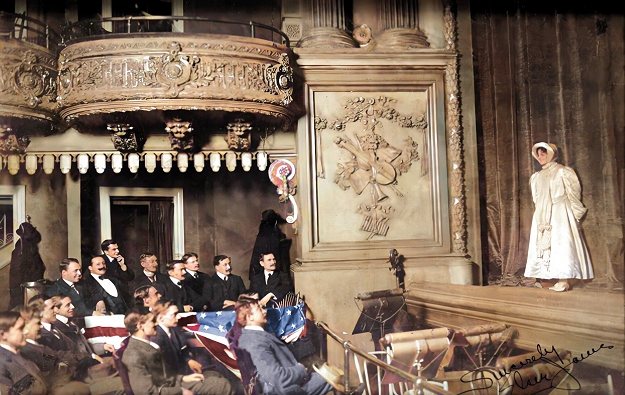 |
Elsie's success was enough to get her signed to a five year agreement with producer Charles Dillingham who worked at finding viable properties for the young actress. Their professional relationship would last for nearly two decades. One of the first opportunities presented was a starring role in The Hoyden which went 65 performances in its first run. Elsie was on her way, now known as a brilliant young comedic actor and ragtime singer. Her picture and name started appearing on sheet music covers and in magazines. However, Little Elsie was little no more, and at 18 was to be taken quite seriously. While she was a pleasant singer, she would never headline in that capacity alone, using all of her acquired talents to sell her performances. Josephine continued to manage Elsie's career, in spite of occasional protestations from more experienced theatrical managers. In the end, it was likely that Elsie could have done better financially with a better manager, but she remained loyal to Josephine, and still did not make out too badly.
As for Percy, his ability began to grow, but his work was still often associated with Elsie's appearances, including The Vanderbilt Cup. In that 1906 to 1907 production Percy had a small on-stage part,
but was also tapped as a stage manager. His on stage work was enough to get him an audition, followed by a good role as Chris Hazy, the "lame boy," in a London production of Mrs. Wiggs of the Cabbage Patch in the spring of 1907. Percy had hoped to emerge from his talented sister's shadow, and become a famous actor in his own right. He was to meet his mother and sister in London after rehearsals were through. Sailing to the United Kingdom on the S.S. Minneapolis, Percy disappeared on the night of April 14. Having no other viable explanation, it was surmised that he fell overboard and was lost at sea. The family had no reason to believe that it was a suicide as he was very happy about his new venture. A memorial was subsequently set up for him by his mother in her family's plot at Oak Grove Cemetery in Delaware County, Ohio.
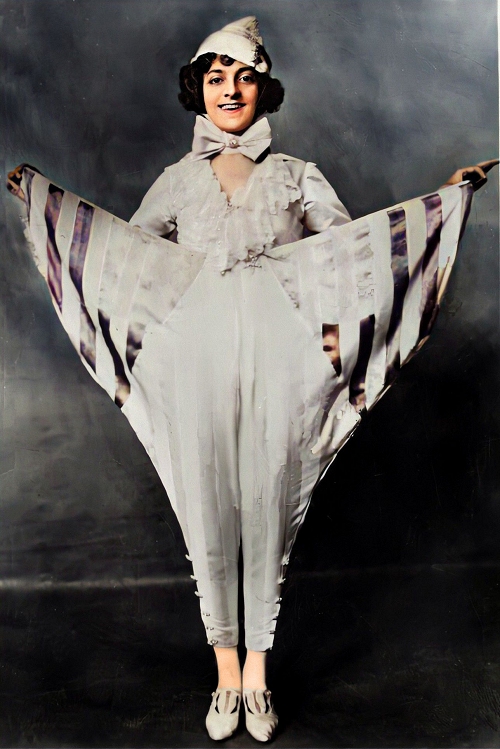 |
The first of many tours that Elsie and Josephine would make to Europe was to France in mid-1908, likely traveling with The Hoyden. They were shown arriving back in New York on the Rotterdam on August 3rd, just in time for her to engage in a new show. The next big production, The Fair Co-Ed, started on the road in 1908, affording Elsie a visit to her home town of Columbus where she was very well received. The local paper raved about her acting, singing and dancing. The show ended up in New York in 1909 playing 136 performances.
At some point in 1910, mother and daughter took a break and were found back in Columbus for the 1910 enumeration. Elsie was listed as an actress with a theatrical company, and Josephine as her divorced mother, but with 13 years trimmed off her life showing an age of just 35 to Elsie's deflated 18. The same information appears in the Ohio Miracord census for that year. She was one of the top paid stars of the stage in the still-developing entertainment industry, pulling in between $2,500 and $3,000 per week in 1910, either in stage musicals or vaudeville appearances. This was equivalent to two other top American female stars, Nora Bayes and Eva Tanguay.
Next up was an English play brought to America, The Slim Princess, which opened on the road in 1910. This production, which went for 104 performances on Broadway in 1911, also introduced Elsie as a songwriter, her entry being I'd Rather Love What I Cannot Have, Than Have What I Cannot Love. It also signaled a transition into full adulthood for some of her fans and reviewers, as the following from The Music Trade Review of October 8, 1910 will attest:
It is Miss Elsie Janis now, if you please. No more little Elsie or even just plain Elsie, for the brilliant young lady is sedate and twenty and the relics of childhood days have been cast aside. 'The Slim Princess,' published by Chappell & Co., is the first play in which Miss Janis has ever worn her hair 'done up,' and considerable dignity attaches itself to this momentous transition...
It is a new young woman who comes to us this year, with the recommendation of her name in electric lights above the Studebaker entrance, a mature and serious-minded young woman whose memories of the days long ago, when she was the 'Little Elsie' of vaudeville fame, are quite dim and hazy. Do not imagine that in personality the fair Elsie is less popular than ever, for no star ever held the affections of a company of stage players with firmer grip than she. But the romping days and the games of baseball with the boys, the decidedly ingenuous jokes on prim uplifters of the stage—all are forgotten by the contemplative and interesting Miss Janis, who no longer insists upon putting tacks in the orchestra leader's chair, as in the boisterous days of old.
In some respects, The Slim Princess became somewhat autobiographical for the actress, who while seen and heard often was rarely found with a romantic partner. It would become known in inner circles that Ms. Janis was potentially either a lesbian or at more likely bisexual, so if she did have relationships of that type they were certainly kept quiet. Her mother's role in Elsie's choice has rarely been explored, which perhaps could have been the result of often warning Elsie about stage door Johnnies or men in general,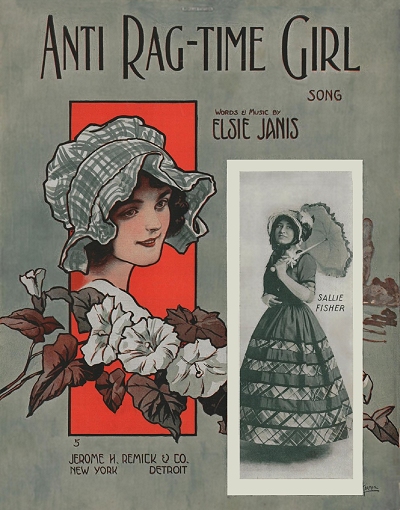 or perhaps from experiences with her father. In any case, Josephine was evidently tolerant of her daughter's choices in this matter. Some of Elsie's energies were put into a book in 1911 called Star for a Night, largely a publicity vehicle for her stage work in the play of the same name. In July of that year Josephine and Elsie ventured to Europe on the Lusitania for another tour, arriving back in early August.
or perhaps from experiences with her father. In any case, Josephine was evidently tolerant of her daughter's choices in this matter. Some of Elsie's energies were put into a book in 1911 called Star for a Night, largely a publicity vehicle for her stage work in the play of the same name. In July of that year Josephine and Elsie ventured to Europe on the Lusitania for another tour, arriving back in early August.
 or perhaps from experiences with her father. In any case, Josephine was evidently tolerant of her daughter's choices in this matter. Some of Elsie's energies were put into a book in 1911 called Star for a Night, largely a publicity vehicle for her stage work in the play of the same name. In July of that year Josephine and Elsie ventured to Europe on the Lusitania for another tour, arriving back in early August.
or perhaps from experiences with her father. In any case, Josephine was evidently tolerant of her daughter's choices in this matter. Some of Elsie's energies were put into a book in 1911 called Star for a Night, largely a publicity vehicle for her stage work in the play of the same name. In July of that year Josephine and Elsie ventured to Europe on the Lusitania for another tour, arriving back in early August.The next couple of years found Elsie doing everything from stage revues to recordings of popular songs. One revue featured her second song, Fo' de Lawd's Sake, Play a Waltz, which had some popularity in New York City. After Over the River, which ran for 120 performances, Elsie won a role in The Lady of the Slipper, running an impressive 232 shows from 1912 to 1913. That summer included a trip to England, returning in August on the Imperator with Josephine, as always, by her side. Her single ragtime song, The Anti-Ragtime Girl, was published in 1913. It comically names off all of the "offensive" dances that the girl in question refuses to participate in, all of them fed by ragtime music. By 1914 Elsie stated her home as the Globe Theater, but Josephine was living in White Plains, New York, a short commute away, which is likely where Elsie spent much of her precious down time. They went to England in the summer of 1914 so Elsie could star in the Passing Show in London.
In London, Elsie became romantically involved with comedian Basil Hallam for a short while, and the couple even cut a few sides together in 1914, then again in 1915. It was in 1914 that Janis did her first entertaining for the boys on their way to war. Elsie and Josephine returned on the Mauretania from Liverpool in October, 1914. There was also a song that Elsie wrote and performed which was this time actually associated with a dance and specific dancers. A Castle Walk Song was composed for the premier dance couple of the time, Vernon and Irene Castle. Vernon had appeared with her in Lady of the Slipper. It should be noted that Elsie only made a handful of sides in the United States for Victor in 1912, of which three were released. For whatever reason, her records sold much better in Europe, and the recording quality was higher, so virtually all subsequent sides were done by the His Master's Voice, the British equivalent of Victor. This makes them much rarer in the United States as collector's items.
Elsie had also worked at the Palace Theater that year, a place that even Al Jolson was not able to get into, and she proved to be quite popular there doing her songs,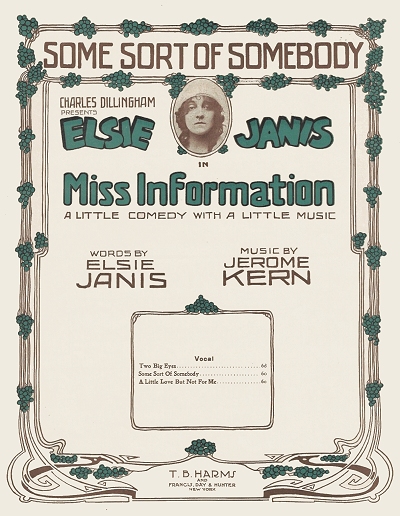 imitations and other comedic material. However, Josephine, who was unflinching in her negotiations when it came to Elsie but also not abusive in that regard, insisted that the theater had not lived up to their promises to the star, and she pulled Elsie from her contract. Owner Edward Albee did not take kindly to this, and he attempted to blackball Elsie from The Palace publicly. His publicity in this regard turned back on him in an ugly way since the public could not imagine any such disagreement would be Elsie's fault, and they in turn came out against the theater creating potential financial issues. In the end, Albee had to send a public letter of apology to Josephine and Elsie, and offered them a much better deal, which worked out for all involved. In the end, the dynamic and perhaps even more famous Al Jolson STILL could not make it into The Palace, even though he evidently did rather brashly crash it one afternoon, perhaps one of the reasons for his being shunned by Albee.
imitations and other comedic material. However, Josephine, who was unflinching in her negotiations when it came to Elsie but also not abusive in that regard, insisted that the theater had not lived up to their promises to the star, and she pulled Elsie from her contract. Owner Edward Albee did not take kindly to this, and he attempted to blackball Elsie from The Palace publicly. His publicity in this regard turned back on him in an ugly way since the public could not imagine any such disagreement would be Elsie's fault, and they in turn came out against the theater creating potential financial issues. In the end, Albee had to send a public letter of apology to Josephine and Elsie, and offered them a much better deal, which worked out for all involved. In the end, the dynamic and perhaps even more famous Al Jolson STILL could not make it into The Palace, even though he evidently did rather brashly crash it one afternoon, perhaps one of the reasons for his being shunned by Albee.
 imitations and other comedic material. However, Josephine, who was unflinching in her negotiations when it came to Elsie but also not abusive in that regard, insisted that the theater had not lived up to their promises to the star, and she pulled Elsie from her contract. Owner Edward Albee did not take kindly to this, and he attempted to blackball Elsie from The Palace publicly. His publicity in this regard turned back on him in an ugly way since the public could not imagine any such disagreement would be Elsie's fault, and they in turn came out against the theater creating potential financial issues. In the end, Albee had to send a public letter of apology to Josephine and Elsie, and offered them a much better deal, which worked out for all involved. In the end, the dynamic and perhaps even more famous Al Jolson STILL could not make it into The Palace, even though he evidently did rather brashly crash it one afternoon, perhaps one of the reasons for his being shunned by Albee.
imitations and other comedic material. However, Josephine, who was unflinching in her negotiations when it came to Elsie but also not abusive in that regard, insisted that the theater had not lived up to their promises to the star, and she pulled Elsie from her contract. Owner Edward Albee did not take kindly to this, and he attempted to blackball Elsie from The Palace publicly. His publicity in this regard turned back on him in an ugly way since the public could not imagine any such disagreement would be Elsie's fault, and they in turn came out against the theater creating potential financial issues. In the end, Albee had to send a public letter of apology to Josephine and Elsie, and offered them a much better deal, which worked out for all involved. In the end, the dynamic and perhaps even more famous Al Jolson STILL could not make it into The Palace, even though he evidently did rather brashly crash it one afternoon, perhaps one of the reasons for his being shunned by Albee.1915 turned out to be a productive year for Elsie. A second book appeared titled Love Letters of an Actress, a fictional series of letters showing the progression of a number of humorous love relationships. She also entered into a film career, making four movies for Paramount Pictures, writing the scenarios (the early version of a screenplay) for all four of them. This was followed by a collaboration with the up and coming composer Jerome Kern. Kern and Janis came up with the show Miss Information, which may have turned out to be a little bit "miss-guided" in execution, closing in just around 6 weeks. After another trip overseas for a new edition of The Passing Show, While there she again became briefly involved again with Basil Hallam, but did not respect his concerns about the potential of being drafted for the growing war effort. Elsie ended that relationship and returned on the St. Louis in August. Hallam would end up dying in uniform in 1916, and many believe that Elsie never quite got over the loss.
Upon her return Elsie immediately went into a show made from the remnants of Miss Information, also written with Kern, titled Very Good Eddie. The writers evidently got this one right, for it started in the Princess Theater late in the year, went to two other theaters during its Broadway tenure, and closed again at the Princess after an accumulative 341 performances. This was followed in late 1916 by the ostentatious and very expensive Ziegfeld production The Century Girl which itself went around 200 performances.
The fortunes of mother and daughter Janis were enough that Josephine was able to secure a shrewd deal for a home in Tarrytown, New York, known as the Talleyrand, which they named The Manor House. There they were able to live in style, most certainly in a manner quite different from Josephine's rural Ohio upbringing.
They added a tennis court and an English garden, fully refurbishing the historic property as well. When in New York, both of them frequented the Algonquin Hotel where the famous inner circle of literary and musical figures held court for many years.
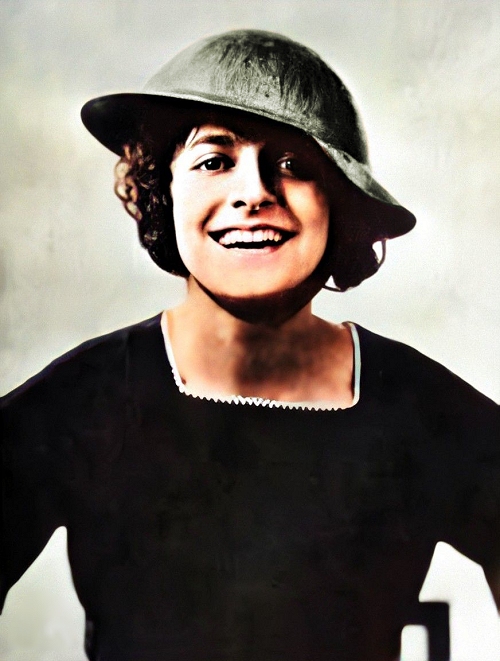 |
Following her earlier efforts to give the troops morale in a time of war, Elsie committed herself to doing this for all of the doughboys in Europe, and set out on a six month tour into the war zone. One previous trip, sponsored in part the YMCA and Salvation Army, as the U.S. Government was neutral and would not commit to backing her, established her as a cherished presence near the battlefields, so it was not hard to encourage further support, or perhaps aggressively negotiate for it since Josephine did the leg work, for this extended tour. Elsie's passport issued December 19, 1917, showed her traveling "to France and England. To France to make a tour of hospitals and rest camps through the racket and for tours to sing and entertain THE BOYS." Josephine's applications stated she was going "To assist Elsie Janis to fulfill theatrical contract. Mother/Personal Manager." This trip was when Elsie clearly earned her title "Sweetheart of the A.E.F."
With Josephine by her side taking the same risks, Elsie was not considered as much a glamour girl as she was one of the guys in a sense, Her small troupe traveled around in pickup trucks or similar vehicles, using them as a makeshift stage. She would perform for anywhere from fifty to five thousand soldiers at one time, always to vigorous cheering, and even learned enough French to extend her act into the realm of French troops as well. They all looked forward to sing-alongs at the end, something that allowed the boys to participate in a way that reminded them of the folks back at home. Out of this experience came a 1919 book, The Big Show: My Six Months with the American Expeditionary Forces, and a documentary movie along the same lines called The Big Drive. She also appeared in one of the earliest Warner Brothers Vitaphone sound shorts, Elsie Janis Behind the Lines at the Front, shot in 1926. (This is currently available on DVD on The Jazz Singer set.) Elsie's selfless example in this regard clearly set the stage for what would eventually become the U.S.O. in advance of World War II.
After an extended stay following the war, continuing to entertain through Europe, Elsie and Josephine returned to the United States on the Rotterdam from Plymouth, England, on August 31, 1919.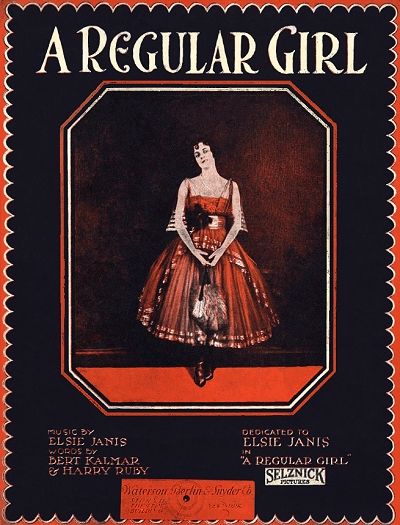 They were met in the harbor by a tugboat with a banner reading "Welcome Home Elsie Janis," and to a swelling crowd in port, having endeared herself to the American public even more during her time away. Unable to return to the stage owing to an Actors Equity strike that all but closed New York theaters, Elsie went back into film, working for a time for the Selznick Picture Corporation. One of the films was A Regular Girl for which she wrote the screenplay and a title song. She also prepared a new show based on her experiences in the war called Elsie Janis and Her Gang in a Bomb Proof Revue. When she finally got clearance to return to the stage, the show started on December 1 and played through mid-January os 1920, going briefly on the road after 55 performances on Broadway.
They were met in the harbor by a tugboat with a banner reading "Welcome Home Elsie Janis," and to a swelling crowd in port, having endeared herself to the American public even more during her time away. Unable to return to the stage owing to an Actors Equity strike that all but closed New York theaters, Elsie went back into film, working for a time for the Selznick Picture Corporation. One of the films was A Regular Girl for which she wrote the screenplay and a title song. She also prepared a new show based on her experiences in the war called Elsie Janis and Her Gang in a Bomb Proof Revue. When she finally got clearance to return to the stage, the show started on December 1 and played through mid-January os 1920, going briefly on the road after 55 performances on Broadway.
 They were met in the harbor by a tugboat with a banner reading "Welcome Home Elsie Janis," and to a swelling crowd in port, having endeared herself to the American public even more during her time away. Unable to return to the stage owing to an Actors Equity strike that all but closed New York theaters, Elsie went back into film, working for a time for the Selznick Picture Corporation. One of the films was A Regular Girl for which she wrote the screenplay and a title song. She also prepared a new show based on her experiences in the war called Elsie Janis and Her Gang in a Bomb Proof Revue. When she finally got clearance to return to the stage, the show started on December 1 and played through mid-January os 1920, going briefly on the road after 55 performances on Broadway.
They were met in the harbor by a tugboat with a banner reading "Welcome Home Elsie Janis," and to a swelling crowd in port, having endeared herself to the American public even more during her time away. Unable to return to the stage owing to an Actors Equity strike that all but closed New York theaters, Elsie went back into film, working for a time for the Selznick Picture Corporation. One of the films was A Regular Girl for which she wrote the screenplay and a title song. She also prepared a new show based on her experiences in the war called Elsie Janis and Her Gang in a Bomb Proof Revue. When she finally got clearance to return to the stage, the show started on December 1 and played through mid-January os 1920, going briefly on the road after 55 performances on Broadway.The 1920 census showed Elsie and Josephine residing in Talleyrand at Tarrytown, with Elsie as an actress in motion pictures (in spite of her current stage work), and Josephine as 46 (adding a year to her previous claim), divorced, and manager for her daughter. Also in the household were five servants: a housekeeper, a chauffeur, a cook, a waitress, and a gardener to maintain the large property. Either because of the shift of the film industry to Hollywood, or perhaps since her company had gone out there, Elsie purchased a house in Los Angeles in early 1920, and would eventually trade up to Beverly Hills. On an April 1920 passport application she is shown as residing in Los Angeles. However, Elsie again recognized that she worked better in front of a live audience that could give her feedback, rather than in front of the camera. So she took another show to Europe and the United Kingdom in 1920, It's All Wrong: A Musical Complaint, followed by a tour of Elsie in Paris, actually staged in Paris in 1921, arriving back on the Titanic's surviving sister ship The Olympic on August 31.
Once back in the United States the actress attempted a new rendition of Elsie Janis and Her Gang which played from January through March for only 56 performances. Not able to capture the same energy after the war that she had before, and competing with the new acts emerging in the frenetic jazz age 1920s, her fortunes started to fade. Appearing wherever Josephine could get her booked, usually in Europe, she still worked fairly consistently through the decade. In 1925 Elsie got good some exposure in Puzzles of 1925, but after 104 nights the show closed.
Her best effort of that year was the clever book If I Know What I Mean, one of the first that discussed her relationship with her tenacious manager mother. Elsie was also spending more time in Los Angeles, having bought an estate in Beverly Hills. Among her best friends there were actress and "America's Sweetheart," Mary Pickford, and her husband Douglas Fairbanks.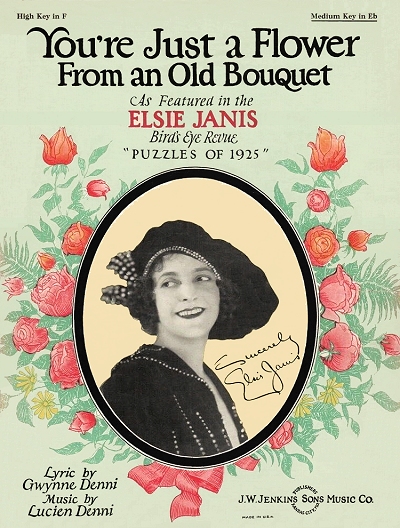 Another book came out in 1926 called Counter Currents, co-authored by Marguerite Aspinwall. It was followed Behind the Lines for Vitaphone. Josephine and Elsie made two trips to France in 1926 and 1927. Another book came out in 1928 featuring contributions by Elsie. In her stage imitations of the famous Will Rogers she had become quite adept with a lariat herself, thus her role in the book Roping: Trick and Fancy Rope Spinning along with Rogers and actor Fred Stone.
Another book came out in 1926 called Counter Currents, co-authored by Marguerite Aspinwall. It was followed Behind the Lines for Vitaphone. Josephine and Elsie made two trips to France in 1926 and 1927. Another book came out in 1928 featuring contributions by Elsie. In her stage imitations of the famous Will Rogers she had become quite adept with a lariat herself, thus her role in the book Roping: Trick and Fancy Rope Spinning along with Rogers and actor Fred Stone.
 Another book came out in 1926 called Counter Currents, co-authored by Marguerite Aspinwall. It was followed Behind the Lines for Vitaphone. Josephine and Elsie made two trips to France in 1926 and 1927. Another book came out in 1928 featuring contributions by Elsie. In her stage imitations of the famous Will Rogers she had become quite adept with a lariat herself, thus her role in the book Roping: Trick and Fancy Rope Spinning along with Rogers and actor Fred Stone.
Another book came out in 1926 called Counter Currents, co-authored by Marguerite Aspinwall. It was followed Behind the Lines for Vitaphone. Josephine and Elsie made two trips to France in 1926 and 1927. Another book came out in 1928 featuring contributions by Elsie. In her stage imitations of the famous Will Rogers she had become quite adept with a lariat herself, thus her role in the book Roping: Trick and Fancy Rope Spinning along with Rogers and actor Fred Stone.One of Elsie's last Broadway appearances was in the George Gershwin musical Oh Kay!, which garnered inconsistent reviews, followed by a film adaptation of the same. On the last record that shows what is perhaps Elsie's final trip to Europe in early 1929, Josephine's name is absent. This would turn out to be the beginning of a very different phase of life for Elsie.
As the Great Depression was just underway, the 1930 census showed Elsie now living in Beverly Hills with Josephine, the latter listed as widowed (if there is a story to that we were not able to find it) and 58, a step closer to her actual age. Elsie listed herself in her new profession, a writer for motion pictures. Living with them was one cook and a domestic servant. Indeed, Elsie started to amass film credits as a writer of both stories and dialogue. Among these were Close Harmony, Madam Satan, Reaching for the Moon and The Squaw Man. She also had several more compositions added to her musical credits. But it was also in 1930 that Josephine (Jennie), Elsie's constant companion, and at times both her biggest fan and driving force, finally passed on. Elsie took the loss of her mother hard, and buried herself in her behind the scenes film work.
In what turned out to be a questionable decision, Elsie married Gilbert Wilson before the year was out. He was a stockbroker who was only 24 to her 41, and some termed it a marriage on paper only.
However, in a 1936 letter reprinted in Time Magazine, and originally appearing in the Tarrytown News, she noted that after her mother died, "I had asked for a helpmate who would understand me. He came and was young enough to be as inexperienced in the fundamentals of mating as Old Maid Janis was at 42 [sic]. Result: Four years of two being one completely, and now an understanding of what is what. He is young enough to make a new life for himself, if orders are such..." The intent of that last line is unclear, but it was perhaps a harbinger of what was to come. As for what had already been, she attempted another autobiography in 1932, updated from a first attempt in 1928, and optimistically titled So Far, So Good.
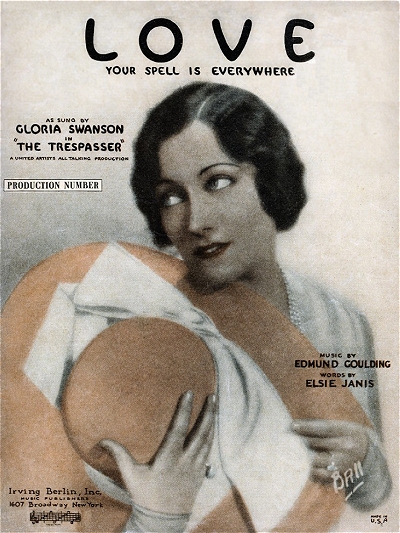 |
Early on in the marriage, Elsie evidently tried to turn the stockbroker into an actor with mixed results that created tensions. Perhaps a better indicator of the nature of their relationship is that she finally got him cast in a Noel Coward revue in 1934, Set to Music, and Gilbert soon became a frequent party companion to the gay playwright. Elsie herself was known to appear at parties with company as diverse as the "notoriously libidinous" actress Marilyn Miller at her side. She also attempted another show, staging New Faces of 1934, which ran from March through July for a respectable (given the times) 159 performances. But Elsie's lifestyle was fraught with drawbacks during the Great Depression, and her fortunes started to diminish.
A serious automobile accident in 1935 created issues both with Elsie's body and her finances. In September, 1936 she made a move which prompted the Time Magazine letter printed above, selling her beloved Tarrytown Manor House and most of the possessions within during a three day auction. While she attributed this as "Orders for G.H.Q." (General Head Quarters as she referred to God), it was more likely to help keep the couple solvent and in their Beverly Hills home where she spent more time. The property soon ended up in the hands of John D. Rockefeller Jr.. Through the second half of the decade Elsie and Gilbert spent more time apart than together.
While spending most of her time on the West Coast in the late 1930s, Elsie did attempt a Broadway comeback that was short lived. Her self-titled variety show, Elsie Janis, sort of a throwback to vaudeville with narration infused, opened on New Years Day 1939, and disappeared after a mere four performances. She was also involved with Frank Fay Vaudeville, a nostalgic revue, which fared a bit better, lasting for 60 performances from March through late April of the same year. But that was it for Elsie Janis and the theater. Just the same, as of the 1940 census, taken in Beverly Hills with her as Elsie J. Wilson, both she and Gilbert were still listed as theater actors (as opposed to film) with two servants residing in the rear quarters. She appeared once more on screen in 1941 in the film Women in War, playing a nurse in France.
As for the real war, Elsie's husband Gilbert enlisted in the Army on April 22, 1941, and was shipped overseas for around five years. His enlistment showed him as an actor or entertainer born in Illinois and still married. As for Elsie, the car accident had pushed her into somewhat of a religious conversion and she started an involvement with the church that continued through most of the rest of her life. She participated in benefit performances, was involved with four war time patriotic concerts, appeared on radio whenever there was an opportunity, and spent fifteen years visiting veterans of past and present conflicts reading to them, writing to them, and honoring them however she could. At one point during World War II she even worked with Bob Hope, who had pretty much taken over the role of entertainment ambassador that Elsie had held since before America entered World War I in 1917.
In 1946 when Gilbert returned it was clear to the couple that no real marriage existed. Rather than divorce they simply chose to live separate lives. In retrospect she was still loved, having had a number of works of music and poems and other literature dedicated to her. The 1950 census taken in Beverly Hills showed her as separated, and with no occupation, but still supporting a maid and a chauffeur. The number of articles that she had been writing for various magazines about her life and her associations with other stars started to trickle down to virtually no output. Other than her visits to veterans she was rarely in the public eye any more and spent most of her last decade as a recluse in Beverly Hills.
When the end came in 1956 she was attended to by her longtime friend Mary Pickford, who was at Elsie's side when she passed on. Another past friend was there as well. She had a framed photograph of her first real love, Basil Hallam, on the table next to her bed. While Pickford had been America's Sweetheart for so long, Janis still remained the American Soldier's Gal Pal, and was well remembered by many, particularly those of the armed forces. Her career had spanned vaudeville from before ragtime up through the height of swing and movie musicals. Her selflessness in recognizing and honoring those who fought for the United States set an example that continues to be practied among many entertainers to this day. Little Elsie Bierbower from Ohio had finally made good, but the show had closed, and it was time to take the pictures down.
Some of the information on Ms. Janis' life was gleaned by many biographies, including two of her own; magazine articles, including some she penned; theater reviews; and copious newspaper articles and listings. The remainder was researched by the author, delving into census records, passports, passenger lists, and some deep family histories going back to the 1850s. The information on her origins leading up to 1905 or so is as accurate as can be presented based on public records, and is often contrary to known information on Janis and her mother, some of which was clearly fabricated by the two women. Corrections or addendums are most certainly welcome with corroborating information.

 Compositions
Compositions